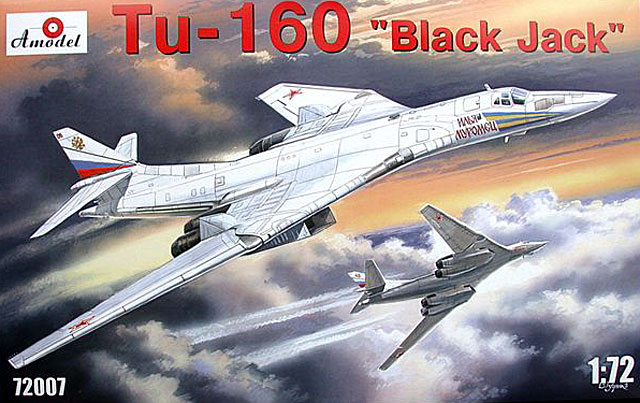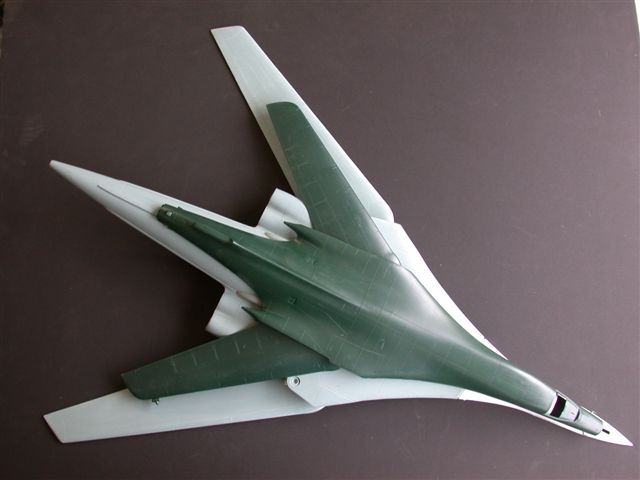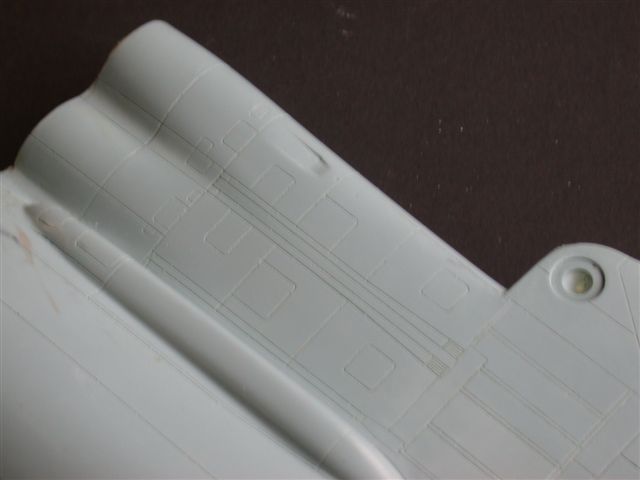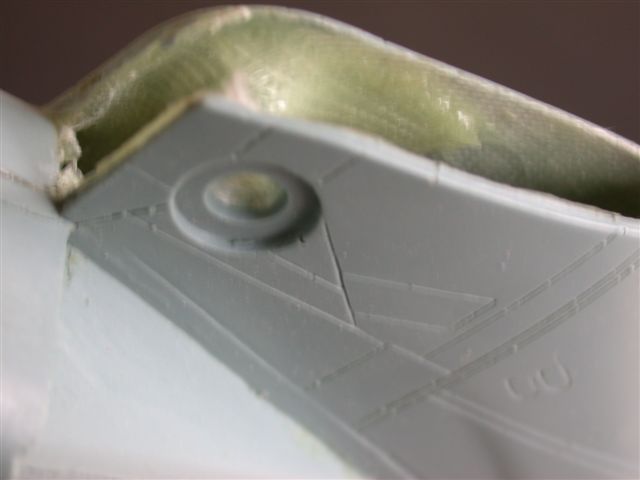|
Tupolev Tu-160 "Blackjack"

Amodel

HyperScale is proudly supported by Squadron.com
S
u m m a r y
|
| Catalogue Number: |
72-007 |
| Scale: |
1/72 |
| Contents and Media: |
See Text |
| Price: |
Pre-Order Price USD$195.00 Obtained from Linden Hill
Imports |
| Review Type: |
First Look |
| Advantages: |
Epoxy glass construction overcomes
wing droop problems; improved surface details and engraving; petite injected details; decent instructions. |
| Disadvantages: |
Time required for cleanup due to hard epoxy
parts; some flash; ; flat-finish decals |
| Recommendation: |
Recommended to experienced modelers,
but finicky Tamiyagawa assemblers need not apply! |
Reviewed by "Bondo Phil" Brandt
The Tu-160 "Blackjack" was the Soviet Union's forceful response,
albeit at least three years later (1977), to the B-1. Unlike the B-1
development which was constantly under intense financial and political
scrutiny (including program cancellation at one point), the Blackjack
design team enjoyed no such restrictions; after all, the Cold War was
still in full stride.
The result was a strategic weapon system that, although bearing an
uncanny physical resemblance to the Bone, was superior in most aspects
with the notable exception of avionics and penetration aids (read EWO).
That is, the Blackjack's airframe is approximately twenty-five percent
larger; power is approximately two and one-half times greater; maximum
speed is almost twice as much (Mach 2 capable because of variable intake
geometry); and range is over twice that of the Bone!
Further, the Blackjack was designed from the outset to carry
conventional as well as nuclear weapons; the Bone's expensive CMUP
conventional weapons upgrade came only after Gulf War I.
The breakup of the Soviet Union almost fatally affected Blackjack
operations, not to mention series production. First, the newly
independent Ukraine demanded big bucks for its no-longer-needed
Blackjack fleet. A settlement was finally reached, the airframes were
flown to Russia and treaty scrapping of early airframes began, partially
funded (at least eight million dollars!) by the U.S. Today's Tu-160
fleet numbers but sixteen active aircraft, only one-fifteenth of current
Bone assets.
This is a BIG airframe, as the picture of the Monogram Bone overlaid
on the Blackjack shows.

Ukraine-based Amodel has really picked up the pace with this, the
latest in the "Monster" series of limited releases (72007). Such a large
airplane dictates the use of Amodel's characteristic epoxy glass
fuselage and, in this kit, epoxy glass wings as well.
With the well-documented wing strength issues of the huge Revellogram
1/48 Bone, Amodel's epoxy glass method seems to be a thoughtful
solution.
Molding
Amodel has definitely picked up the pace as far as surface quality
and engraving of the epoxy glass components. There are significantly
less panel line flaws, as there were in the Bear kit, and the surfaces
seem much smoother. Overall molding -- there are no less than
twenty-four sprues! -- is decent; slightly "soft", with very little if
any, flash and typical larger spigots to cut and sand off; I saw only a
couple of sink marks. Some very petite parts are well-cast but will need
care when separating from their spigots.

Engraving of injected components is excellent, as good or better as
what we've come to expect from other limited production kits.
Bondo hasn't had an opportunity -- he just received the kit today --
to check fit, although experience with three other Amodel releases tells
me there probably will be some areas that will need adjustment. But, as
I've mentioned before on HyperScale, that's just another day at the
office here at Bondo Industries.
Click the thumbnails below
to view larger images:
Fuselage
The main fuselage consists of the customary Amodel monolithic epoxy
glass layup, with halves epoxied together at the factory. As with the
Tu-4 "Sotka" kit, there are some large areas that will need to be
razor-sawed out to allow gear bay, intake trunk and wingsweep mechanism
insertion. The forward eight inches of fuselage is done in injected
halves, as are the multipiece, built-up forward sections of the variable
jet intakes. If desired, the refueling receptacle may be displayed open
with the probe erected.
Cockpit
The cockpit components are better than some previous Amodel releases:
fairly petite instrument panels, sidewalls, bulkheads and consoles.
Raised details are just about right, judicious drybrushing should
provide the proper degree of cockpit "busy-ness." K36 seats each consist
of five parts, and harnesses are molded in. The seat detail is somewhat
soft, but it's not really a big thing since, unlike the "Backfire C",
the crew position hatches only open upon ejection; the crew enters up
through the nosegear well. The canopy has been cast in one piece, has
the same fine engraving but is somewhat thicker and not as clear than
those of Tamiyagawa; but it's certainly not grossly done.
Engines
Injected compressor faces are inserted up through a sawed-out slot in
each engine area. Burner assemblies are seven-piece, with no annoying
seams to fill. Depth will be about two inches.
Wings and Tail
As covered above, the wings are strong, complete units of hand-laid
epoxy glass. One wing has a small, raised bump which will have to be
sanded off, although with the overall white paint scheme, the
discrepancy may just blend into the background!
Two injected "glove" assemblies must be CA'ed onto the wings, and the
wings are then connected with a sweep mechanism.

A three-part injected hinge pin - much like the real thing - anchors
each wing to the carry-through area.
Tail flying surfaces are injected, with all-pivoting vertical fin and
slabs.
Landing Gear
Finely cast, multipiece struts and six-wheel bogies look great, but
will again need careful separation from sprue and some flash cleanup.
Amodel has gone with separate tires and hubs which will make painting
the fourteen wheels a breeze. Each maingear wheel bay is built up of
eight parts and is sufficiently "busy."
Weapons
Since the Blackjack carries all weapons internally, no weapons or
bays are included.
Decals
The Blackjack fleet has always sported an all-white color scheme with
large splashes of color fore and aft. Each aircraft is named, in large,
red Cyrillic script, for a famous Russian. This kit (Red 06) honors
Il'ya Muromets and is only the second production Tu-160 to be named.

Complete markings, including many, many tiny stencils are included,
although all are done in the annoying ESCI-type flat finish.
Bondo loves Amodel's eclectic spirit!
Regardless of the added labor required, that's the fun of this hobby.
Regardless of the not-small kit price, few firms have seen fit to do
these important Cold War participants.
Recommended.
Review and Images Copyright © 2003 by
Phil Brandt
Page Created 17 November, 2003
Last updated 16 November, 2003
Back to HyperScale Main Page
Back to Reviews Page
|
Home | What's
New | Features
| Gallery |
Reviews | Reference
| Forum
| Search